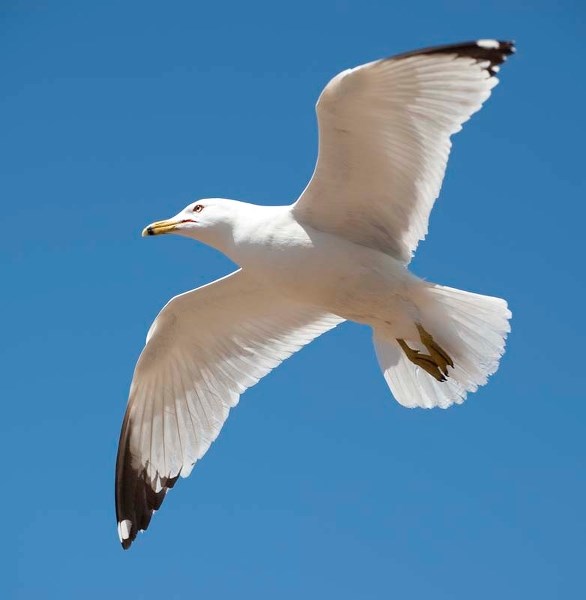Ever take an up-close look at a ring-billed gull?
They're actually kind of freaky. They've got eerie creamy-yellow eyes ringed with blood-red flesh, proud, hawkish heads and huge wings. Their golden beaks seem set in a perpetual frown as they glare at the world in disapproval.
And then they start squealing like pigs and you remember how silly they are.
The ring-billed gull is the most common form of gull we have in St. Albert. Ubiquitous around shopping malls, parking lots and garbage dumps, they're the pigs of the air, snacking on any trash they can find as they fly, squeal and defecate everywhere.
The birds themselves are white with a grey back, black-tipped wings, and a black ring around their bills. Herring gulls do not have that ring, while California gulls have that ring plus a red spot.
Ring-billed gulls are likely now the most common gull in North America, reports Hinterland Who's Who – a sharp change from the 1800s, when their numbers plummeted due to the demand for feathered hats.
The 1916 Migratory Birds Convention gave these birds the protection they needed to thrive, says Jean-François Giroux, a biologist at the University of Quebec in Montreal who recently lead a four-year study of them around Montreal.
Humans also created many artificial islands the birds now use as breeding grounds, and provided tonnes of free food in the form of landfills.
Canada now has millions of the things, Giroux says. About 50,000 breeding pairs camp out just 10 kilometres from downtown Montreal alone.
"The numbers have increased exponentially," he said.
Gulls are extremely used to people, being one of the few birds that will hang out within touching distance of you.
"They're quite used to getting fed by people," Giroux explains, and will eat pretty much anything. His team found that human food (in the form of trash) makes up about 70 per cent of a young ring-billed gull's diet.
Ring-billed gulls are very social birds, known to hang out in huge mobs going "hiyah hiyah hiyaah!" or "gah gah gah."
In the cities, ring-billed gulls act as garbage collectors, eating our refuse, says Jocelyn Hudon, curator of ornithology at the Royal Alberta Museum. In the country, you'll see them following plows to snack on worms and grasshoppers.
Ring-billed gulls breed in huge colonies on islands that give them protection from predators.
Giroux says these gulls tend to be very faithful to their breeding colonies and return to them every year.
Some even dine out at the same restaurants.
"We have some birds that leave Montreal and stop in at the same McDonald's in Connecticut four falls in a row," Giroux says.
Stool pigeons?
Ring-billed gulls have another, much less flattering name, Hudon notes. This name rhymes with "sit-hawk" and relates to the birds' propensity for defecating on everything, potentially damaging cars and buildings, Giroux notes.
They can also be dangerous when they collide with planes at airports.
"They are noisy," he continues, and some transport diseases in their feces.
That's lead to a lot of research into how to control their populations.
Shooting them is generally ineffective as new ones will simply move in, Giroux notes. Some landfills have had success deterring the birds with falcons.
Restaurant owners should be diligent about picking up dropped food if they want to deter ring-billed gulls, says Robert MacDonald of Wildlife Control Services. Spikes can keep the birds off lampposts, while shiny CDs on strings can deter them from roofs.
Recent moves towards incineration, landfill closures and better waste management (such as covering waste daily instead of leaving it in the open) have actually put a dent into Canada's ring-billed gull population, Giroux says – there's been about a 15 per cent decline in their numbers in the last 15 years in Eastern Canada.
Hudon doesn't think ring-billed gulls deserve their bad reputation.
"They're neat looking birds, they're right in your backyard and they clean up the street," he says.
"If we're providing garbage, that's our problem."
Ring-billed gull
Name:
Larus delawarensis.
Appearance:
Medium-sized gull with a grey back, white body, black wingtips, yellow feet and a black ring around its yellow bill.
Commonly seen:
Hanging around parking lots eating junk food with its buddies, or soaring high above, going "hiyah hiyah hiyah!" Found in massive numbers at the 170 Street landfill just south of St. Albert.
Occasionally confused with:
Herring gulls, which are bigger, have pink legs and no ring on the bill; and California gulls, which have a red spot on the bill in addition to a black ring.
Fun fact:
They catch flying ants on the wing during the fall.
Wild St. Albert
Like wildlife? So do we! Every second Wednesday the Gazette profiles a reasonably common wild creature in the St. Albert region. Birds, beasts, bugs, fish … so long as it's alive and kicking, we'll feature it. <br /><br />Got a creature you'd like to see profiled? Send your suggestions to [email protected].




